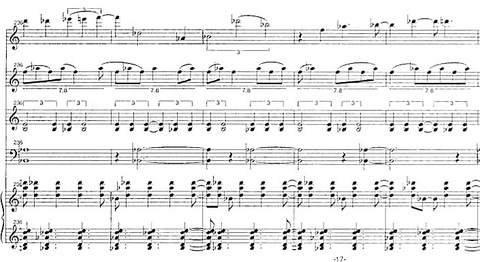I wrote my “American Composer” column for Chamber Music magazine this month – though it won’t be out till March – on John Halle, one of the eight composers of the Common Sense collective. And, as often happens, I obtained a generous influx of his music, so I uploaded seven pieces to PostClassic Radio. John’s vocal music employs political texts – from Project for the New American Century, Larry Summers, D.C. activist Sam Smith – that sound pretty shocking when set to music with seeming innocence. (Much the way, I suppose, that Allan Kozinn once wrote that Custer’s hate-spewing memoires sound in my Custer and Sitting Bull.) My real interest, though, is in John’s rhythms, a typical example given here from his 1997 piece Spooks (the instruments are flute, oboe, violin, cello, and two guitars):Â
Freedom Caught in Notation
Look at that: triplets moving to dotted quarters in the flute, septuplets grouped in sixes in the oboe, triplet quarters grouped in fives and fours in the violin, five-beat patterns in the cello and first guitar, over a dotted-quarter pulse in the second guitar. Pure totalism. You can tell me no such style exists, and I’ll bury you with examples. Call it whatever you want, I don’t care. Metametrics. And that doesn’t at all mean that John’s music sounds like Michael Gordon’s, Ben Neill’s, Evan Ziporyn’s, Mikel Rouse’s, Art Jarvinen’s, mine, and so on. He’s got his own fresh way of speeding up and slowing down through lines nonsynchronously over a pulse that ties everything together, more jazz-sounding than the other totalists (he started out as a jazz pianist), and the music would sound improvised if the harmonies didn’t fit together so snugly. Amazing stuff.
John Halle is a man after my own heart. He used to be an alderman in New Haven, and his political writings are fearless. One of the first things Google attributes to him is an article on the wealth tax, and over at his humble-looking web site, he’s got some excellent articles on musical politics, including the best debunking yet of Joseph Straus’s MQ article claiming that the 12-toners never wielded any power in academia, and a report on the nefarious dealings of Mario Davidovsky. The kind of stuff that, were I to post it here, 20 people would write in to cry foul – and yet it’s god’s own truth. God bless ‘im.

